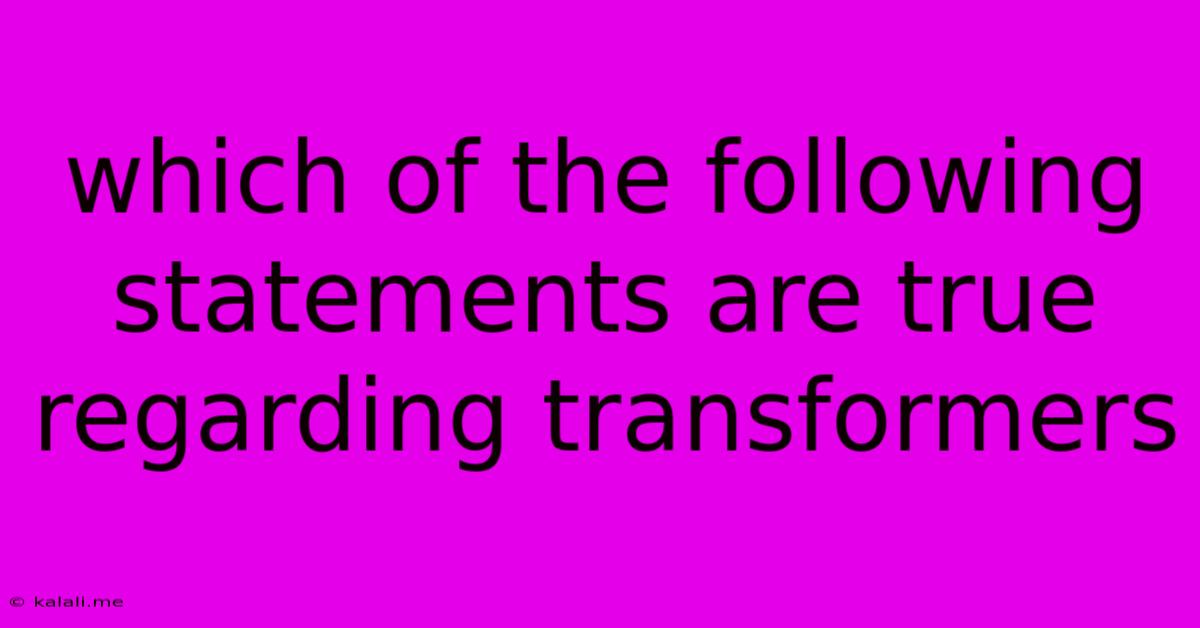Which Of The Following Statements Are True Regarding Transformers
Kalali
Jun 15, 2025 · 3 min read

Table of Contents
Which of the Following Statements Are True Regarding Transformers?
This article explores common statements about transformers and determines their veracity. Understanding transformer architecture is crucial for anyone working with natural language processing (NLP) or other deep learning applications. We'll examine several claims, separating fact from fiction, and providing clear explanations for each. This will improve your understanding of this powerful deep learning model.
Key Statements and Their Accuracy:
Let's examine some frequently encountered statements about transformers and assess their accuracy:
1. Transformers rely solely on self-attention mechanisms for processing sequential data.
TRUE. While some variations might incorporate other mechanisms, the core innovation of the transformer architecture is its reliance on the self-attention mechanism. This allows the model to weigh the importance of different parts of the input sequence when processing it, unlike recurrent neural networks (RNNs) which process sequentially. This parallel processing capability is a significant advantage, enabling faster training and processing of longer sequences.
2. Transformers are inherently superior to Recurrent Neural Networks (RNNs) in all NLP tasks.
FALSE. While transformers have demonstrated superior performance in many NLP tasks, especially those involving long sequences, they are not universally superior to RNNs. RNNs still hold advantages in specific scenarios, particularly those requiring processing of short sequences or tasks where the sequential nature of the data is crucial. The "best" model is highly dependent on the specific task and dataset.
3. The attention mechanism in transformers allows for parallel processing of the input sequence.
TRUE. This is a key advantage of transformers. Unlike RNNs, which process the input sequence sequentially, the attention mechanism allows the model to consider all parts of the input simultaneously. This parallel processing significantly speeds up training and allows for the handling of much longer sequences than RNNs can effectively manage.
4. Transformers require significantly more computational resources than RNNs.
TRUE. Due to the quadratic complexity of the self-attention mechanism (O(n²), where n is sequence length), transformers generally demand significantly more computational resources than RNNs, especially when dealing with long sequences. This higher computational cost is often offset by their superior performance on many complex NLP tasks.
5. Positional encoding is necessary for transformers to understand the order of words in a sequence.
TRUE. Self-attention mechanisms are permutation-invariant, meaning they don't inherently understand the order of words in a sequence. Positional encoding, which adds information about the position of each word in the sequence, is crucial for the transformer to learn the sequential relationships between words. Various positional encoding schemes exist, like absolute and relative positional embeddings.
6. The encoder-decoder structure is essential for all transformer-based models.
FALSE. While the original Transformer architecture used an encoder-decoder structure (like in machine translation), many successful transformer-based models, such as BERT, rely solely on the encoder part. These encoder-only models are well-suited for tasks like text classification and question answering.
7. Transformers are only applicable to natural language processing tasks.
FALSE. Although transformers gained prominence in NLP, their applications extend far beyond. They are successfully used in various domains, including computer vision (e.g., Vision Transformers), time series analysis, and protein structure prediction. The adaptability of the self-attention mechanism makes it a powerful tool across various fields dealing with sequential or structured data.
Conclusion:
Understanding the nuances of transformer architecture is essential for effectively leveraging its power. This analysis clarifies some prevalent misconceptions and highlights the strengths and limitations of this influential deep learning model. Remember that the "best" model remains highly context-dependent, and the choice between transformers and other architectures should be driven by the specific task and available resources.
Latest Posts
Latest Posts
-
How To Create A Joint Probability Table
Jun 15, 2025
-
What Organelles Contain Their Own Dna
Jun 15, 2025
-
Stevens Institute Of Technology Average Sat
Jun 15, 2025
-
Moment Of Inertia Of A T Section
Jun 15, 2025
-
What Is The Prime Factorization Of 216
Jun 15, 2025
Related Post
Thank you for visiting our website which covers about Which Of The Following Statements Are True Regarding Transformers . We hope the information provided has been useful to you. Feel free to contact us if you have any questions or need further assistance. See you next time and don't miss to bookmark.